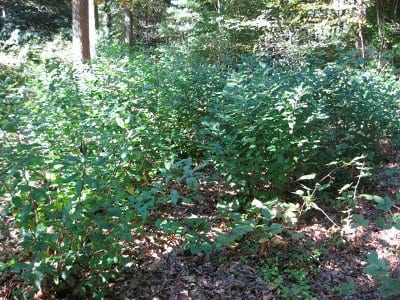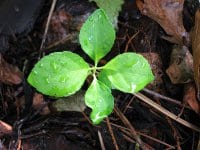by Bruce Wenning
Parts I and II of this article appeared in the September 2011 issue of the ELA Newsletter. Part III includes individual fact sheets. A list of fact sheets and links appear at the end of this article.
Part III
Landscape and Ecosystem Damage: A Brief Introduction
The ecological damage caused by exotic invasive plants to our native landscapes appears variable or inconsistent early on during the invasion process. However, as years pass, the exotic invasive populations increase and continue to expand into susceptible soils resulting in native plant and soil ecological disruption/degradation if left unchecked. Depending upon the exotic invasive species and where it has colonized among native plant assemblages, the ecosystem damage can include one or more of the following over time (Randall, 1996; Cronk and Fuller, 1995).
1. Native plant succession is affected. The continuous growth and spread of exotic invasive plants in native landscapes contribute to the interruption and/or overtaking of some native plant species succession. Most exotic invasive plants exhibit rapid growth and prolific seeding which, in time, creates more shaded conditions than if they were not present in the first place. The shade greatly impacts native plant species that are not shade tolerant. In other words, the increase in the exotic invasive plant population displaces native plant populations that are partial to full shade intolerant. This action eventually alters affected native plant germination, growth, and establishment patterns of the infested area.
For example, I have seen glossy buckthorn stands so dense that the native red oak, Quercus rubra, and white pine, Pinus strobus, over story was not successful at reproducing on the forest floor below. Too much growing space was taken up and shade created by glossy buckthorn for these partial shade-tolerant native species to germinate and become successfully established. Over time, the area became a red oak, white pine over story with a glossy buckthorn (shrub) understory.
2. Native seed banks are contaminated.
When left unchecked, the presence of the exotic invasive plant or plants prove to be a continuous, long-term source of seeds for further invasion of new areas and re-invasion of the invaded area (e.g. germinating glossy buckthorns take up more space and create more shade which inhibits some light-loving native plants from successfully germinating and becoming established).
3. Ecosystem processes may be altered. These pestiferous plants alter many ecosystem processes including but not limited to plant-soil fertility cycles; decomposition rates of litter layers; soil erosion rates; and water table levels, all of which affect soil food web interactions and populations. Additionally, some exotic invasive plants may hybridize with closely related native species.
4. Animal population food sources are affected. Native and non-native animal populations may shift in distribution patterns and population size by favoring exotic invasive plant species as an alternative food source to native plant (food) sources. This especially occurs when species such as glossy buckthorn, common buckthorn, and Asiatic bittersweet vine reach high population levels.
The Components of a Sound Monitoring System
According to Cloyd, et al (2004), monitoring or visually inspecting your property for any pest problem is paramount for determining the need for IPM control options in any environmentally effective pest management program. The components of a sound monitoring program for exotic invasive plants include the following:
(1) You! That’s right. You must be motivated to carry out exotic invasive plant removal or find a landscaper that will do it for you. Begin to explore your property and surrounding woodlands.
(2) Properly identifying exotic invasive plants when monitoring the landscape of your concern. The frequency of your monitoring activities is up to you and can be done at any time of the year. However, the most effective monitoring schedules must include visits when leaves are out (late spring to early summer) and just before leaf drop (early fall when buds are fully formed). Most plant identification photos are taken during these times, and novices tend to select leaf shape and arrangement as their first botanical character for plant identification and buds as their second. These time frames are best for detecting recently germinated plants as well as established individuals and/or larger populations not previously detected. If you are having difficulty with plant identification, ask knowledgeable people, such as nursery personnel, university extension agents, garden club people, or local nature center staff, for help. You will need to rely on good plant identification books, pamphlets, and websites to integrate your learning with acquired field experience.
(3) Monitoring all locations of a property and recording all exotic invasive species and associated native species present is necessary. Make special note of the susceptible sites not yet colonized by exotic invasive species. Keep all written monitoring records for a year-to-year comparison. This is the only way that you will be able to see if the myriad of exotic invasive species of concern are increasing, decreasing, or remaining the same.
(4) Recording all worksite activities, personnel involved, and tools used is necessary. Always keep records of herbicides used; tools and other equipment; species controlled by chemical and non-chemical methods; dates and times; weather conditions; site or property locations; and all personnel involved. Creating and maintaining accurate records will provide you with a worksite history for determining future management plans.
Your success will depend on an intact, continuous monitoring schedule and your commitment to control procedures year after year. Your monitoring efforts should be integrated into routine landscape maintenance activities. Your goal is to open up space occupied by exotic invasive plants and keep those spaces free from exotic invasive plant invasion. This is necessary whether you are working in a small backyard or on a large estate. Successful exotic invasive species control occurs on one property at a time.
Individual Exotic Invasive Plant Fact Sheets:
About the Author
Bruce Wenning has university degrees in plant pathology and entomology and is an ELA Board member and regular contributor to the ELA Newsletter. Bruce also spearheads the effort to expand ELA’s website content. Watch for his upcoming articles with information about individual invasive species. He is a horticulturist at The Country Club, Brookline, MA where he continues his battle with exotic invasive plant species.



